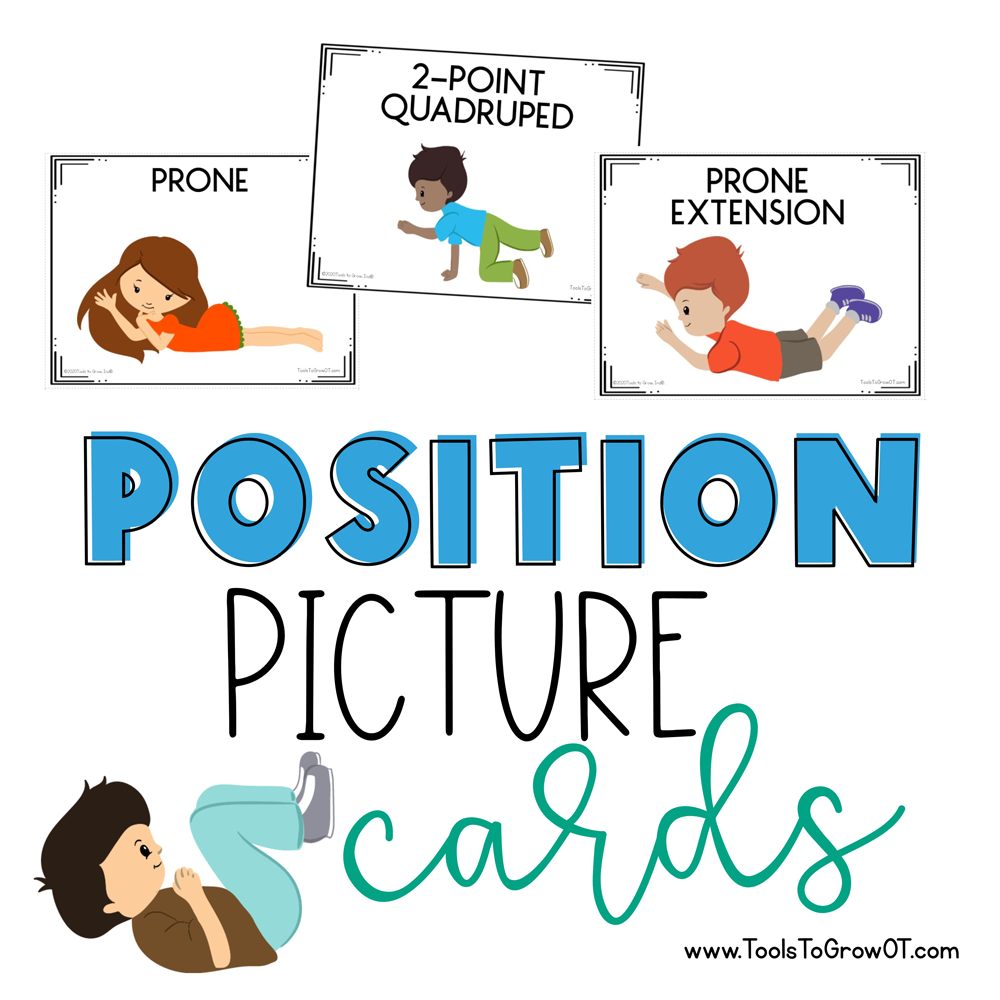Primitive Motor Reflexes & Their Impact on a Child's Function
01.11.2016
This blog will focus on the motor challenges faced by children in the early childhood to school age years with minimal to moderate motor delays that continue to be influenced by what have been described as Primitive Motor Reflexes.

A Reflex is a stereotyped response to a sensory stimulus. For the purpose of this blog, minimal to moderate motor delays will exclude children with severe deficits in mobility and gross motor functioning. This includes the need for moderate to maximum physical assistance from others to ambulate.
The Primitive Tonic Reflexes appear in infancy and are integrated into normal movement patterns as the infant develops during the first 6-12 months of life. These reflexes are thought to help the infant learn to organize motor behavior. Integration refers to the inhibition by higher centers of neurological control which modify the reflex in such a way that the pattern of response is no longer stereotypical. The reflex does not disappear; it may reactivate under stress or during activities requiring great strength. If these so called primitive reflexes are persistently displayed beyond the expected or typical developmental time period, their presence has been considered an indication that underlying developmental or neurological issues may exist. When these reflexes do not integrate, they may interfere with a child’s development of more advanced motor skills. If such a delay or disruption in motor skills exists, there may be an impairment in the child’s occupational performance. That is where an Occupational Therapist’s skillful assessment and intervention will make the difference for the child!
This blog will review tonic reflexes, their significance if the reflex persists beyond the typical age range, and the possible impact on a child’s functioning and role performance. Last but not least, this blog will suggest therapeutic interventions that are known to help inhibit the activation of tonic reflexes and advance postural control as a foundation for optimal functioning.
TONIC REFLEXES:
REVIEW OF HOW THESE PRESENT DURING INFANCY
Asymmetrical Tonic Neck Reflex (ATNR):

Onset: 0-2 months
Integration: 4-6months
Stimulus: Rotation of the head
Response: Arm and leg on the “jaw” side extends. Arm and leg on the “skull” side flex.
Importance for Baby: Assists with early eye-hand regard, provides vestibular stimulation, changes the distribution of muscle tone.
Significance on Early Development if Persists: May impair ability to roll, use hands smoothly together at midline, poor visual regard for object(s) being held, poor balance. May impair creeping or crawling. Baby loses balance and/or falls when rotates his head from midline; very frustrating and causes excessive fatigue.
Symmetrical Tonic Neck Reflex (STNR):
 Onset: 4-6 months
Onset: 4-6 months
Integration: 8-12 months
Stimulus: Flexion and extension of the head (neck)
Response: With neck flexion the upper extremities will flex and the lower extremities will extend. With neck extension the upper extremities will extend and the lower extremities will flex.
Importance for Baby: The STNR assists in the development of bilateral patterns of body movement. Allows child to move up against gravity and assume quadruped (on all four’s like a dog). Integrates as child begins to crawl and can lift the buttocks from the heels without flexing the neck. Integrated when rocking back and forth on hands and knees.
Significance on Early Development if Persists: Interferes with advanced reciprocal creeping. Impairs dissociation between the two lower extremities and transitioning between quadruped to sitting to kneeling to standing and vice versa. If strongly influenced by the STNR a baby will not be able to creep; will bunny hop versus true creeping/crawling on the floor.
Tonic Labyrinthine-Prone & Supine (TLR):

Onset: Birth
Integration: 6 months
Stimulus: Change of orientation of the head in space; position of head in relation to gravity while prone (on belly) and supine (on back).
Response: In prone flexor tone will predominate with arms flexed by the child’s chest. In supine extensor tone will predominate.
Importance for Baby: Allows baby’s posture to adapt to that of the head.
Significance on Early Development if Persists: Will interfere with movement that requires smooth grading of flexor and extensor muscles. In supine child will have compromised ability to raise head up against gravity; this will affect anti-gravity control for movements such as bringing feet and hands together and rolling. In prone (on belly) child will have compromised ability to raise head, extend spine, and bear weight on elbows. This, in turn, will limit time spent on his/her tummy for crawling and developing the movement in their pelvis and shoulders that sets the stage for moving in and out of various body positions (sitting to stand). Without such ability, the baby will be without options for exploring. This will affect social and cognitive gains.
PERSISTENT TONIC REFLEXES:
HOW THESE MAY PRESENT IN EARLY CHILDHOOD
& SCHOOL AGE CHILDREN
Influence of Retained Asymmetrical Tonic Neck Reflex (ATNR):
- Poor Isolation of Individual Body Movements- Ongoing influence by the ATNR may have affected the child’s earlier success with creeping or crawling. The skill of crawling has a developmental sequence of its own. In the beginning the baby simply uses his arms to push himself backward. Ultimately the baby should use quick alternating movements of their arms/legs while only two of four limbs are touching the surface; indicative of intact balance, strength, and ability to isolate movement. Children with poor isolation of individual body parts may also show poor grading and accuracy when moving.
- Poor Sitting Posture- Child may sit asymmetrically in a chair; the arm and leg on the “jaw” side of the face extend & torso rotates away from midline. Because child is not upright and centered in a chair, he/she appears “inattentive” and perhaps “disruptive” when sitting at a table with peers.
- Attention & Focus- When child turns his/her head, their whole body may also turn. This is very distracting and may interfere with task compliance. The child will be less capable at performing multiple actions. For example, he may not be able to use his eyes to scan the classroom (with a stable head) while folding his paper in one-half (using both hands together) as directed by the teacher.
- Impaired Pre-writing & Writing- Writing requires isolated and precise movement of individual body parts; the continued presence of the ATNR interferes with this. When the child rotates his head away from midline, one arm will be influenced to extend and the other to flex. This will impair the stabilization of the paper with non-dominant hand and controlled use of writing tools with the dominant hand. The child may compensate with an immature pencil grasp and need frequent reminders from their teacher to hold his paper. Copying from one source (ex: the board) to another (ex: paper on their desk) requires dissociation of the eyes from the head; the continued presence of the ATNR will also affect this.
- Impaired Scissor Use- Rather than holding the paper at midline and cutting forward, the child may use scissors to cut “laterally”. The non-dominant hand may tightly clutch paper versus lightly grasping and shifting as needed. This impairs independence, precision, and speed.
- Fasteners/Tying/Musical Instruments- The solid foundation for using both sides of the body for different movements is missing. Hands are unable to work together smoothly; eyes struggle to view what hands are manipulating.
- Impairments in Reading- Reading requires quick and smooth eye movements; child may have very poor ability to dissociate eye from head movement to quickly localize, scan, track, and shift their gaze between targets. The child may lose his/her place and have difficulty locating specific letters, words, or sentences on a page.
- Keyboard Use- Will impair ability to keep both hands properly positioned at midline on the home row keys; may need to persist with hunt and peck method.
- Impairments in Gait- When turning their head off midline while walking, the child’s entire body follows. This interferes with walking in a controlled manner and remaining with peers during physical education/ group movement activities. May appear “disruptive” when required to walk in a line at school.
- Running- Poor reciprocal arm swing; arm fencing posture may present because running requires extra strength and endurance. Overall speed and accuracy will be reduced. May not keep up with peers during movement games and physical education.
Influence of Retained Symmetrical Tonic Neck Reflex (STNR):
- Decreased Strength & Balance- Ongoing influence by the STNR may have affected the child’s earlier success with creeping or crawling; the child may have used the Bunny Hop method which requires less balance, strength, and control. Without these pre-requisites, equilibrium or optimal balance will not be realized. Balance is not just necessary for gymnastics, it is also needed for basic skills such as kicking a ball, going up/down stairs, and stepping down from a curb.
- Sitting- Slouches while sitting in a chair; slumps at his/her desk. More likely to fall out of chair than other classmates.
- Floor Sitting- More likely to W sit. This may lead to overstretching in some muscle groups and tightness in others. Over time, this may further limit the child’s flexibility and ability to spontaneously sit in a variety of sitting postures.
- Walking- May predispose children to walk up on their toes rather than flat feet.
- Writing- Places their head on their non-writing arm on the desk while writing with their dominant hand. Very slow copying skills; each time child’s head moves up (extends) or down (flexes) there will be movement in the arms that may interfere with the motor act of writing.
- Ball Handling Skills- Are immature; difficulty with throwing and catching. Strong hands are need for sports such as playing baseball or basketball.
Influence of Retained Tonic Labyrinthine Reflex (TLR):
- Walking- May present as extra cautious; the child lacks strong arms necessary to protect from trips and falls.
- Sitting- Slouches while sitting in a chair; can sit upright for short periods.
- Writing- Leans down over the page when writing.
- Balance- Difficulty with stairs, curbs, bus steps and managing uneven terrain.
COMMON FINDINGS AND TREATMENT CONSIDERATIONS
FOR
CHILDREN WITH PERSISTENT TONIC REFLEXES
Common Finding: Delayed or Incomplete Righting and Equilibrium Reactions
If primitive tonic reflexes are poorly integrated, the righting and equilibrium reactions will not optimally mature. If the tonic reflexes persist past the typical developmental age range, it is safe to assume the child’s righting and equilibrium reactions are impaired. The child will be using his/her hands to prop him/herself because of incomplete balance. This will impair bilateral hand use for function; a common concern for referral to Occupational Therapy.
Treatment Considerations: Design treatment that activates mature postural responses (righting and equilibrium reactions) and the influence of the tonic reflexes will be minimized. Increase trunk rotation; this is needed for full expression of mature equilibrium. Reach and move across midline of the body; this is also needed for full expression of mature equilibrium. Promote balance without the use of arms to support self; narrow child’s lower extremity or upper extremity base of support. For example, while child is using his/her arms while prone, skillfully minimize the amount of abduction and external rotation at one, then both hips. Also, while weight bearing on arms, facilitate prone extension with elbows positioned just below the child’s ears, rather than supporting his/her-self on forearms of widely abducted arms. When possible use movable equipment such as balls, swings, tilt boards, bolsters, or T stools.
Common Finding: Decreased Axial Strength & Compensatory Tightening of Certain Muscles
May see poor trunk extension with accompanying shoulder elevation to compensate for reduced strength. The rib cage may be high in the chest and flared. The child may not spontaneously rotate his/her torso while moving to perform functional tasks; instead will over rely on symmetrical flexion/extension patterns. This will compromise efficient movement for performing functional tasks and result in tightening in certain muscles such as the latissimus and pectorals.
Treatment Considerations: The procedure for inhibiting tonic reflexes requires activation of muscles antagonistic to those activated by the primitive responses. For example, to counteract the effects of the tonic labyrinthine (prone), provide intervention designed to increase strength in the posterior trunk musculature. To counteract the effects of the tonic labyrinthine (supine), provide intervention designed to increase strength by moving against gravity with rotation. Regarding flexibility, determine if stretching the muscle groups that “fix” for stability is needed. For example, to stretch the pectorals child stretches arms behind back, stretch the latissimus by externally rotating and reaching up with both arms, stretch the hamstrings by long sitting and touching toes.
Common Finding: Joint laxity or Hypermobility
May see pronated feet, “winging” in the scapula, hypermobile finger joints, hyper-extended knees, and/or lordosis in lumbar spine.
Treatment Considerations: The biomechanical consequence of joint laxity and hypermobility is a poor ability to generate sufficient force for movement. Just as babies develop, when treating be sure to encourage movement in small ranges to develop stability.
SAMPLE INTERVENTION ACTIVITIES
Remember to focus not only on maintaining this static position, but the transition into and out of prone. The child should remain static for brief periods; even minimal weight shifting from the child’s center of gravity may activate the muscles of the spine and shoulder girdle. Remember…upper extremity strength is important for ideal protective extension and use of the arms for transitioning between positions and minimizing the influence of primitive reflexes.
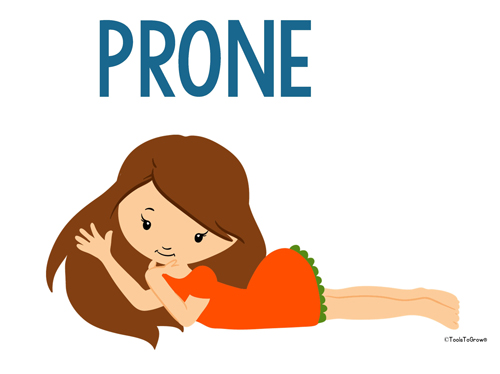
Prone for fine motor activities & games- The elbows provide a point of stability for freeing the hands for manipulating.
1. Hold a large dowel with both hands, use this to push a ball back and forth
2. Use arms to push a ball back and forth
3. Color, print, draw, read, or complete puzzles in prone
4. Use whistles or play games that require blowing through a straw
5. Pivot in both directions
6. Prone on therapy ball, platform swing, or over bolster
7. Prone on scooter board- push off with arms from wall to glide backward
8. Prone on scooter board-being pulled by a rope while grasping onto it with both hands
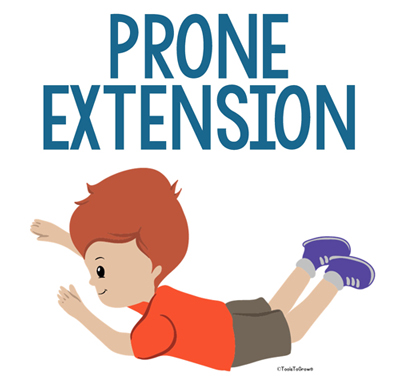
Superman/Super Woman- prone extension with arms and legs fully extended activates muscles antagonistic to the tonic labyrinthine prone reflex
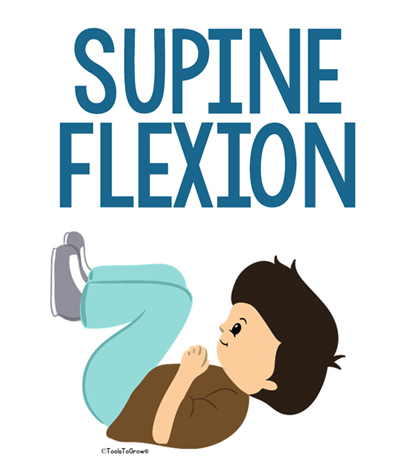
Meatball Position- activates muscles antagonistic to the tonic labyrinthine supine reflex
- Child uses their own hands to place/remove stickers on knees or feet
- Child uses their own hands to place/remove rings from their feet
Supine
- Bounce ball off hands while child’s shoulders flexed to 90 degrees with elbows straight; therapist drops ball from above for child to volley back
- Use legs to kick suspended ball
- Supine on therapy ball; transition into sitting
Bridge Position
Rolling
- Outside-down or up hills
- With arms overhead or at side
- Be sure to encourage chin tuck
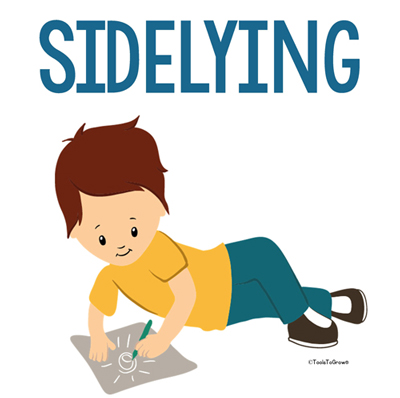
The Sidelying Position offers the opportunity to increase strength and edurance while moving in 3 planes. The child will learn to balance by keeping their head and body oriented in midline; remember to not only focus on maintaining this static position, but transition into and out of sidelying. The child should remain static for brief periods; even minimal weight shifting from the child’s center of gravity may activate head and torso righting. Be sure to encourage the use of this posiiton on their right and left sides. This will lengthen muscles needed for full rotation of the trunk. Remember…full expression of equilibrium reactions require torso rotation and freedom of movement in the upper and lower extremities.
Reach- Use free arm to encourage reaching and other movement/manipulation
- Play games such as Connect Four in high sidelying
- Swat at suspended ball with free arm while in high sidelying
- Work puzzles with free hand while in high sidelying

While Side Sitting strive to have child free both hands free to manipulate object at midline; this may require considerable time and practice. To work toward this encourage the child to adjust to small weight shifts away from their midline. Remember…diagonal control sets the stage for isolation of movement for each limb, important for minimizing the effects of primitive reflexes on functional movement.
- Side Sit
- String beads in side sit
- Lace in side sit
- Toss a ball while side sitting
- Catch a balloon while in side sitting
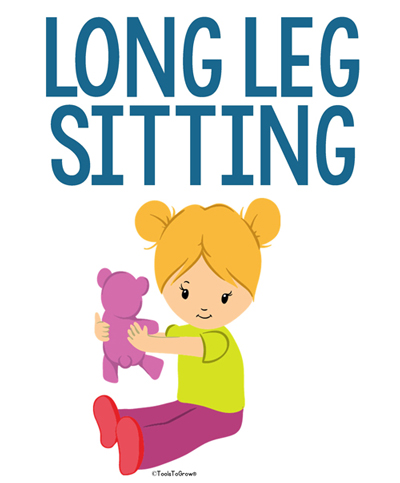
Long Leg Sitting offers the opportunity to stretch muscles that are often tight in children that need to “fix” due to immature balance and ongoing influence from primitive reflexes. This position can help lengthen the hamstrings; a muscle that often tightens as children over-use to stabilize. Strive to have child free both hands to manipulate an object at midline. This position also provides a chance to develop balance by narrowing the child’s base of support.
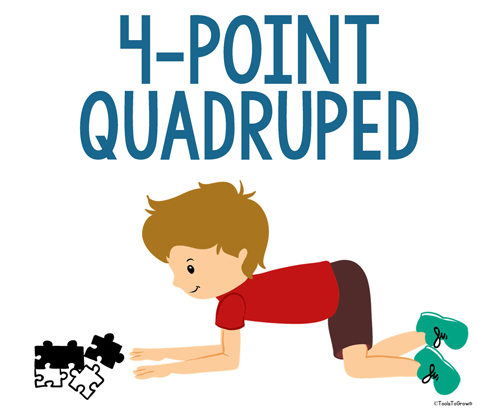
4-Point Quadruped:
- On tilt board
- Turn head side to side, raise head up & down, or “roll” neck without moving knees or hands
- Rock body back & forth or side to side while knees and hands planted
Creeping on Hands & Knees:
- Creep though tunnel forward and backward
- Creep over obstacles such as cushions, pillows, bolsters, etc.
- Creep sideways
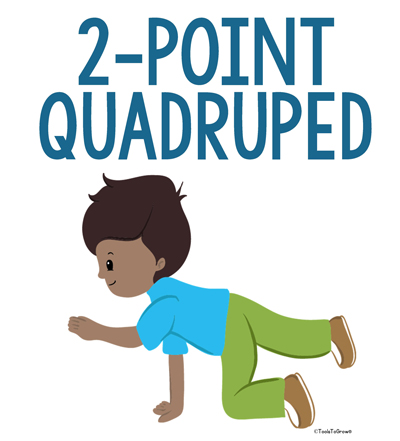
Donkey Kicks- raise one leg into extension, then flex/extend knee so as to kick
Two Point- Maintain one arm & one leg in full extension
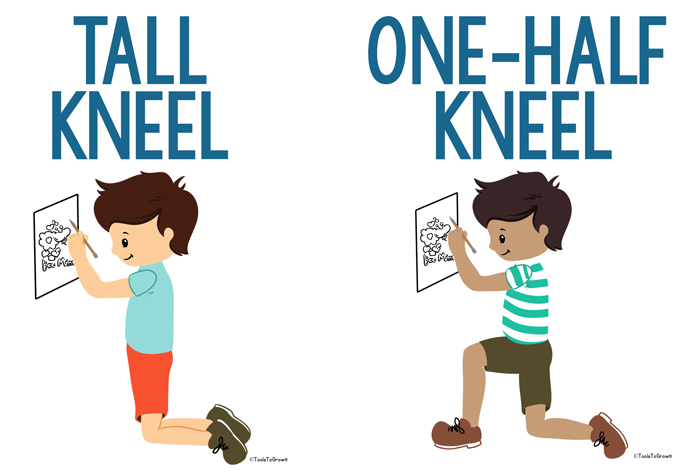
Transitioning between Tall and One-Half Kneel provides an excellent opportunity to develop the strength and balance to not only minimize the influence of primitive reflexes, but to develop the motor planning for energy efficent and functional movments.
- Slowly transition between tall and one-half kneel
- Use hands to complete tasks placed on vertical surface
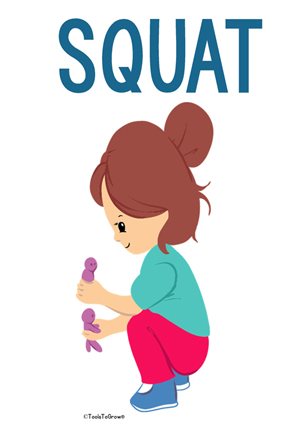
When encouraging transitional movements, such as Standing to Squat, be sure to focus not only on the end position, but accomplishing the movement in a smooth and efficient manner. This will set the stage for the child to adopt this pattern in to their functional movements. Squatting provides opportunity for developing hip stability and balance.
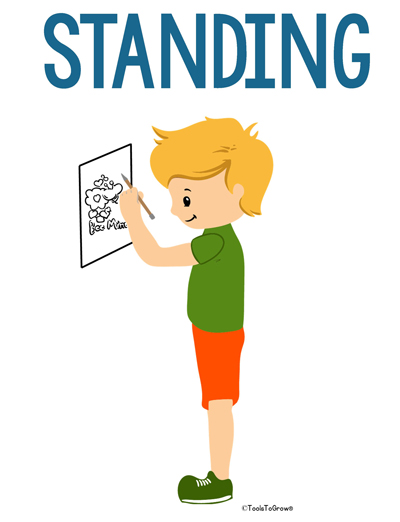
When Standing & Walking:
- Stand and roll a ball up & down the wall with head sideways and arms perpendicular to torso
- Stand and balance on one foot for several seconds
- Hop from one foot to another
- Stand with feet planted while catching a ball thrown slightly out of reach toward his/her side
- Stand facing wall with straight elbows and palms against wall, rotate head left to right without bending elbows
- Stand with back to wall and legs apart; touch right foot to left hand, then left foot to right hand
- Stand while using hands to complete tasks placed on vertical surface
- Walk while holding a tray full of objects; pause and turn head side to side and up/down
- Walk & catch objects with a play fishing pole; use one hand to hold the pole and other to remove “caught” object
Position Resources
Tools to Grow is pleased to present our Position resources!!
Position Picture Cards:
- A fun way to encourage children to develop balance and postural control.
- The process of assuming & maintaining these postures helps minimize the effect of primitive reflexes on a child’s functional movements.
- Encourages the development of strength and endurance while holding anti-gravity positions.
- Helpful for those children that resist adult directed tasks; minimizes possible conflict as the position is determined by “chance”.
- The therapist/adult can customize the use of the body positions in a variety of ways.
- Included is a set of 12 picture cards. Each 4 by 4 inch card has an attractive, easy to copy image of a different position.
Roll a Position:
- This game includes a high quality game card and detailed instructions.
- Child rolls a die and finds the corresponding pictures on the board. He/she can select one of the two.
- With the adults assistance as needed, the child is to assume the position depicted on the game card.
- Use with the accompanying “Position Picture Cards”; these provide a larger view of the posture the child is to assume.
Spin a Position:
- This game includes a high quality game card and detailed instructions.
- Child flicks the spinner and with the adult’s assistance as needed, the child is to assume the position depicted on the spinner.
- Use the accompanying “Position Picture Cards”; these provide a larger view of the posture the child is to assume.
Infographic: FREE Downloadable PDF! Copyright Tools to Grow, Inc. For personal use only.
You can find these NEW Position Resources, Games. and PDF Version of Infographic in 2 Newly Added Sub-Categories:
POSTER & ARTICLE
Visit our Shop find this informative Resource in a Printable E-Book!
Article will Review:
- tonic reflexes - ATNR, TLR, STNR
- significance if the reflex persists beyond the typical age range
- the possible impact on a child’s functioning and role performance
- therapeutic interventions
Related Topics: Core Strength, Early Intervention , Pediatric Neurodevelopmental Treatment , Press Releases, Reflexes , School Based OT


